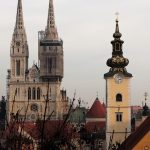A positive Croatian reaction to the refugee summit in Brussels, as Frontex prepares to come to Croatia’s border with Serbia.
“Croatia can be satisfied with the results of the talks in Brussels, which were attended by Western Balkan countries on the refugee route”, Croatian interior minister Ranko Ostojić said yesterday. He added that Frontex observers will supervise situation at the railway station in Šid (Serbia), where the refugees will board the trains and then be transported to a temporary winter camp in Slavonski Brod in Croatia, reports Vecernji List on October 27, 2015.
Frontex (European Border Management Agency) was founded in 2004. Its headquarters are in Warsaw, it has 315 employees and an annual budget of 115 million euros. Depending on the needs, the EU member states put at the disposal of Frontex their police officers, so the actual manpower of Frontex can be significantly higher. Croatian Interior Ministry has been cooperating with Frontex since April 2008 and has participated in a series of its actions.
Minister Ostojić said that the Frontex teams will be deployed at all points along the Western Balkan route and that their task will be to monitor whether everybody is implementing all the items agreed at the meeting. “Each country will establish its own national contact point, and they will use videoconferences to coordinate and exchange information with others. The first videoconference will be held on Thursday at 3 pm”, Ostojić said.
Under the agreement, Greece will remain the only hotspot and has committed, together with the UNHCR, to provide capacity for another 50,000 people. Along the western Balkan route, facilities for another 50,000 people will be provided, and Croatia will participate with a facility for five thousand migrants. These are temporary resting points where refugees will rest and eat before they continue with their journey. Biometric registration of refugees will be carried out in Greece. In Greece, there will be an immediate selection done between the refugees and those who do not enjoy international protection, people coming from safe countries. If these people are caught at border crossings, they will be treated as illegal immigrants and deported back.
“As far as Croatia is concerned, for us the most important thing is that the transit will continue. We would have a problem if someone wanted to make Croatia into an assembly centre. This arrangement will lead to a certain slowing down of the refugee wave, allowing Greece to resolve its hotspots, and Germany to have more time to stabilize the arrival of refugees and to return those who do not enjoy international protection”, Ostojić concluded.
Frontex teams will come to Šid in the next few days, and the basic idea is to slow down the influx of refugees and migrants to Croatia and further to other EU countries which are on the route. The plan is also to prevent the entry from Serbia to Croatia through the so-called “green border”.
The government sources unofficially claim that the Croatian transit centre will be in Slavonski Brod, but if its capacities are not sufficient, a reserve option will again be Opatovac. However, the government has reiterated that Croatia will not be a hotspot, and migrants will be in transit centres just for a short time and then they will be transported further along the route.
In the coming days, Slovenia will try to close the Rigonce entry point through which during the previous days the greatest number of migrants entered from Croatia, announced on Monday the chief migration coordinator in the Slovenian government Bostjan Šefic. He also announced tougher measures to control the migrant wave, if neighbouring countries do not implement the recommendations from Brussels. He added that in the future the procedures with the migrants will include Slovenian financial police and private security companies as well.
According to him, on the border with Croatia somewhat different operating procedure will be introduced. If Croatia starts to announce the arrival of refugees, “the system should function well” because the registration of migrants in Slovenia will be done faster than before. If the obligations discussed in Brussels are not met, which will be seen in the next few days, Slovenia will implement tougher measures on the border with Croatia, details of which he did not want to discuss.
Slovenian foreign minister Karl Erjavec said on Monday that additional measures on the border with Croatia to limit the migrant wave, including reducing the number of entry points, are not out of question if Croatia does not stick to the agreement made in Brussels. Erjavec ruled out recent proposal by Croatian interior minister Ranko Ostojić for migrants from eastern Croatia to be transported directly to the Šentilj border crossing between Slovenia and Austria.
Erjavec said that for Slovenia that is not an option because it would be against the Schengen rules, and everything has to be negotiated with Austria which is admitting fewer and fewer migrants.
From midnight to 21 pm on Monday, 7,104 migrants and refugees entered Croatia. At the temporary reception centre in Opatovac, there are currently 2,618 migrants. Since the beginning of the migration crisis, 260,280 migrants and refugees have entered Croatia.








